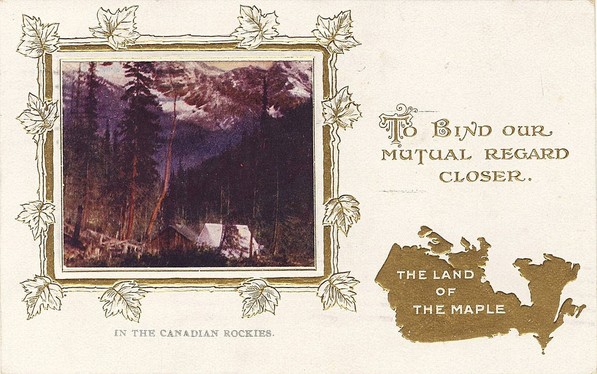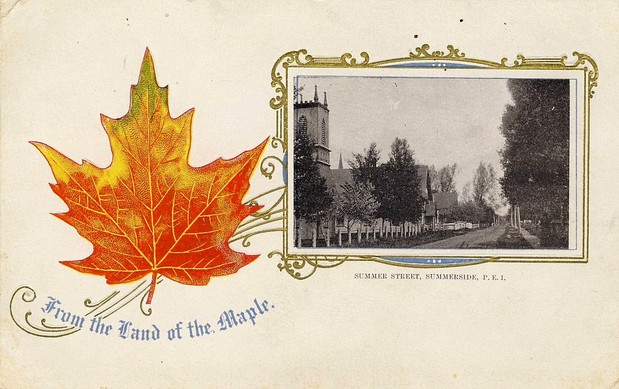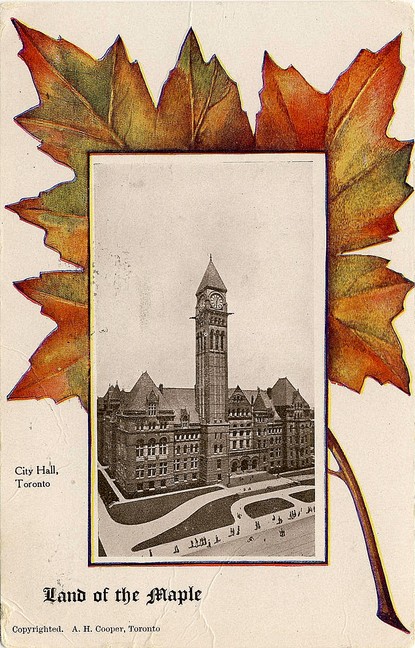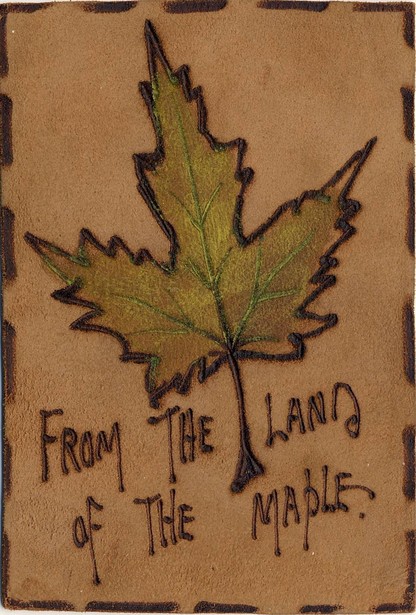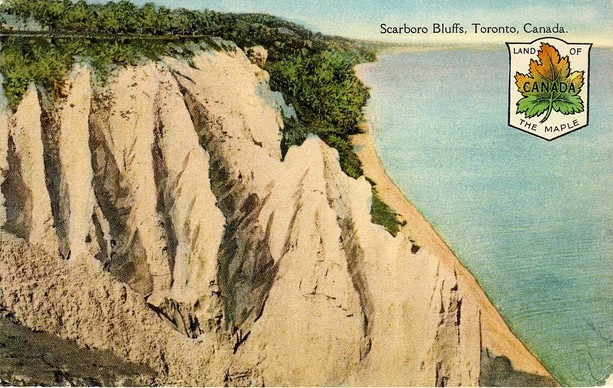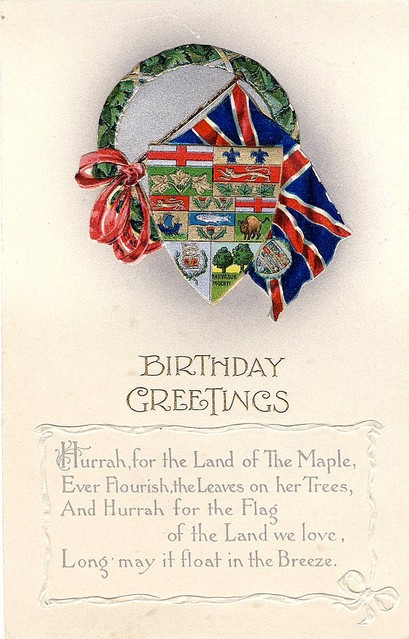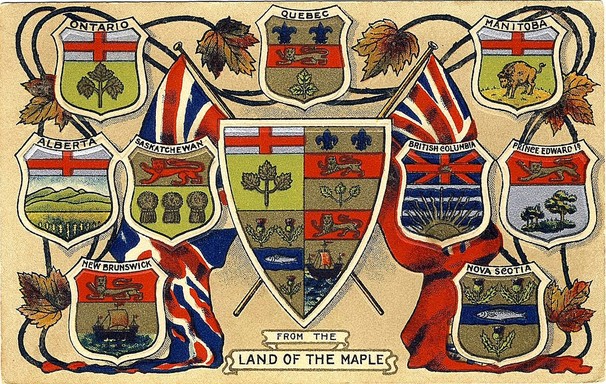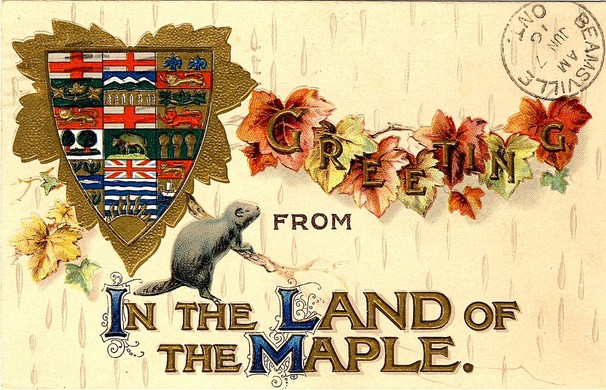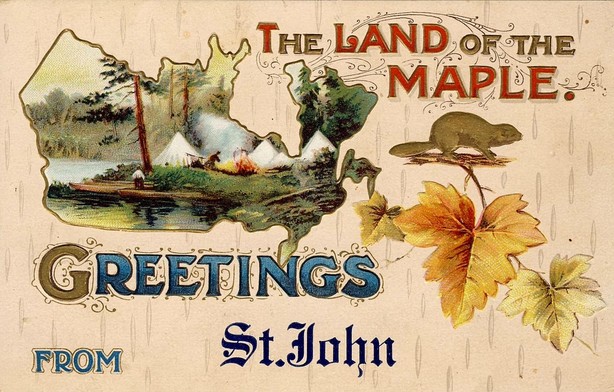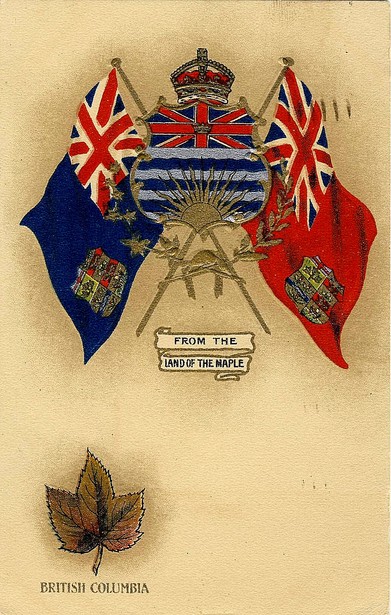Land of the Maple
Auguste Vachon, Outaouais Herald Emeritus
After it was published in 1867, Alexander Muir’s “The Maple Leaf Forever” so dominated the Canadian scene that earlier compositions were almost forgotten. In fact several years before Confederation, a number of songs and poems underlined the special relationship of the maple or its leaf with Canada. At the celebration of the St. John the Baptist’s feast held in Montreal on 30 May 1835, Ludger Duvernay, a printer and publisher, sang verses which described the maple tree as a rallying point for patriots (La Minerve, 27 June 1836, p. 2). The refrain of an 1836 anonymous poem entitled “L’érable” describes Canada’s emblematic links with the maple: “Du Canada, c’est l’érable chérie (sic) / L’arbre sacré, l’arbre de la patrie !” [A. Nantel, Les fleurs de la poésie canadienne (Montreal: Beauchemin & Valois, 1869), pp. 1-3]. Susanna Strickland Moodie’s “The Maple-Tree: a Canadian Song,” views the maple as a source of bounty and a provider of welfare for the nation: “May the nation's peace / With its growth increase … May it grace our soil, / And reward our toil, / Till the nation's heart is dead.” [First published in The Literary Garland in 1847 and republished in her work Roughing it up in the Bush; or, Life in Canada, vol. 2 (London: Richard Bentley, 1852), pp. 292-94]. Around 1850, James Paton Clarke composed a song which places the maple leaf, emblem of Canada, on the same footing as the rose of England, the thistle of Scotland, and the shamrock of Ireland [Music sheet “The Emblem of Canada: Canadian National Song, the Poetry from the Maple Leaf” (Toronto: A. & S. Nordheimer)].
A search through songs and poems and other pre-Confederation documents to find the expression “land of the maple,” or a French equivalent such as pays de l’érable, was to no avail. I discovered these words for the first time in an untitled 1867 poem beginning with “Canada, Canada, land of the maple” published in the Montreal Gazette, July 1, 1867, see: https://www.collectionscanada.gc.ca/confederation/023001-7165-e.html. The message is somewhat diluted by the fact that the first verse of each stanza declares Canada to be the land of something different, namely: the beaver, the snowbird, and the bravest. The notion of identifying the land with the maple did not seem to catch on immediately. It resurged: in H.H. Godffery’s patriotic song “The land of the maple” (Mason & Risch, 1897); in Katherine A. Young, Stories of the Maple Land (Toronto: Copp, Clark, 1898); and in L.-P. Laurendeau’s march “Land of the Maple” (Carl Fischer, 1907).
Postcards were undoubtedly the one medium that most helped spread the expression “land of the maple” before the First World War. These cards were not only produced in large numbers but as series. To encompass many parts of the country, cards were printed with only one feature varying, for instance the central scenery which was often a photograph. The sampling below is representative of the many examples appearing on the market but only scratches the surface of this vast production.
The autumnal maple tree is so characteristic of Canada that it amazes and delights visitors. So many travelers have come to the country prior Confederation that it seems improbable that no one would have declared Canada “land of the maple” prior to 1867. On the other hand, this notion is a rather poetic one, and the early travelers were mostly interested in the utility aspect of the tree: where it grows, its sugar producing sap, its efficiency as firewood, its applications in cabinetry, and the many other uses of its wood.
This year being the 150th anniversary of the Canadian Confederation, it can be intellectually satisfying to think that the phrase “land of the maple” was coined at the time the country was born. Still the possibility remains that someone somewhere recorded this idea earlier. Be that as it may, the postcards presented here reflect the values of many Canadians at a given time in the history of their country.
A search through songs and poems and other pre-Confederation documents to find the expression “land of the maple,” or a French equivalent such as pays de l’érable, was to no avail. I discovered these words for the first time in an untitled 1867 poem beginning with “Canada, Canada, land of the maple” published in the Montreal Gazette, July 1, 1867, see: https://www.collectionscanada.gc.ca/confederation/023001-7165-e.html. The message is somewhat diluted by the fact that the first verse of each stanza declares Canada to be the land of something different, namely: the beaver, the snowbird, and the bravest. The notion of identifying the land with the maple did not seem to catch on immediately. It resurged: in H.H. Godffery’s patriotic song “The land of the maple” (Mason & Risch, 1897); in Katherine A. Young, Stories of the Maple Land (Toronto: Copp, Clark, 1898); and in L.-P. Laurendeau’s march “Land of the Maple” (Carl Fischer, 1907).
Postcards were undoubtedly the one medium that most helped spread the expression “land of the maple” before the First World War. These cards were not only produced in large numbers but as series. To encompass many parts of the country, cards were printed with only one feature varying, for instance the central scenery which was often a photograph. The sampling below is representative of the many examples appearing on the market but only scratches the surface of this vast production.
The autumnal maple tree is so characteristic of Canada that it amazes and delights visitors. So many travelers have come to the country prior Confederation that it seems improbable that no one would have declared Canada “land of the maple” prior to 1867. On the other hand, this notion is a rather poetic one, and the early travelers were mostly interested in the utility aspect of the tree: where it grows, its sugar producing sap, its efficiency as firewood, its applications in cabinetry, and the many other uses of its wood.
This year being the 150th anniversary of the Canadian Confederation, it can be intellectually satisfying to think that the phrase “land of the maple” was coined at the time the country was born. Still the possibility remains that someone somewhere recorded this idea earlier. Be that as it may, the postcards presented here reflect the values of many Canadians at a given time in the history of their country.
N.B.
The cards shown here were collected by Auguste and Paula Vachon. The websites were accessed on 12 March 2017.
The cards shown here were collected by Auguste and Paula Vachon. The websites were accessed on 12 March 2017.
1. This type of postcard was reproduced in series with only the scenery changed. B.B., London Series (Birn Bros.), England, c. 1910-14.
2. Another card turned out in dozens of examples with only the framed scene being replaced. Universal Postal Union, 1905.
3. A further example of a postcard published as a series. A.H. Cooper, Toronto. c. 1910.
4. Some postcards were burnt in leather and painted. Postdated 1906.
5. Many cards were included in this series. The Post Card & Greeting Card Co. Ltd., Toronto, “Canada Series” c. 1935.
6. Valentine-Black Co., Ltd., Toronto, Canada. Made in U.S.A. Postdated 2 March 1929.
7. The shield of the Dominion with only four provinces as advocated by Sir Joseph Pope, see: http://heraldicscienceheraldique.com/dominion-shields.html, figure 14 and the paragraph below. By The Valentine & Sons Publishing Co. Ltd., Montreal and Toronto, printed in Great Britain, postdated 1912.
8. Cards with a few lines of poetry were fairly common. B.B., London. Series (Birn Bros.), England. Sender’s date: 12 November 1912.
9. The Valentine & Sons Publishing Co. Ltd., Montreal and Toronto. Postdated 1913.
10. On this card, the name of a municipality was usually inserted after “FROM.” Other cards in the series show a map of Canada illustrated with a camping scene or a boat on a lake. B.B., London. Series (Birn Bros.), England, E3426, printed in Germany, 1914.
11. Companion card to 9. B.B., London. Series (Birn Bros.), England, E3424, printed in Germany, 1914.
12. A series which included Canada and its provinces. The Valentine & Sons Publishing Co. Ltd., Montreal and Toronto. Postdated 24 August 1912.
13. A nine-province shield representing the Dominion of Canada after 1907. According to the verses, the shield of the maple is the shield of the Land, a poetic way of saying “land of the maple.” B.B., London. Series (Birn Bros.), Made in England. Post dated 1915.
14. This plate does not mention “land of the maple,” although it contains the idea of the tree representing the country. The Royal Doulton mark on the bottom was introduced c. 1930 while the shape of Canada’s shield is prior to 1957. The plate was not likely produced during the Great Depression or the Second World War. Therefore, c. 1950 seems a reasonable approximation. Made in England by Royal Doulton. Vachon Collection, Canadian Museum of History.
